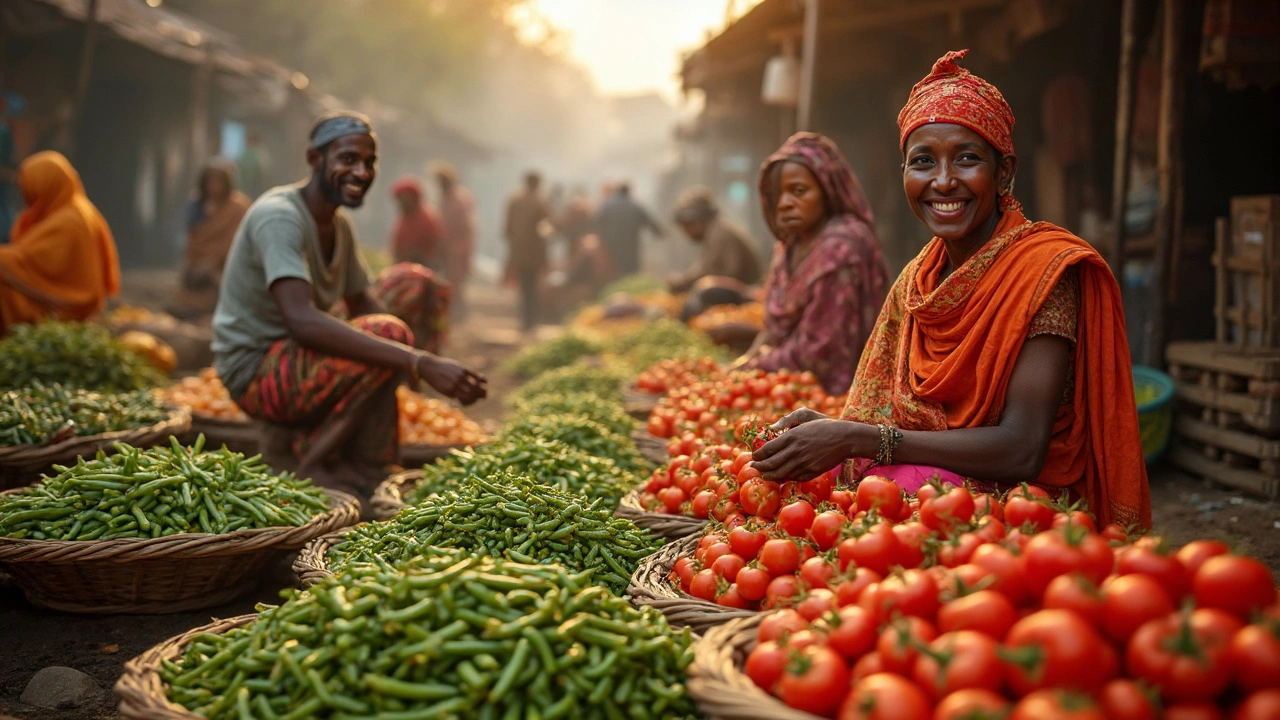Looking for the biggest money-maker in Indian vegetable gardening? Here’s a straight answer: tomatoes usually steal the spotlight when it comes to earning power. If you chat with farmers in Maharashtra or Andhra Pradesh, you’ll probably hear stories about families building houses from tomato profits alone. The market, at peak times, can turn a single acre into pure gold—if you’ve timed things right.
But profit doesn’t just depend on the crop itself. It’s all about hitting that market sweet spot. For tomatoes, prices shoot up in the off-season. Farmers who can manage an early or late harvest often end up doubling or tripling their income compared to others growing at the same time as everyone else. The numbers aren’t small—an acre can pull in up to ₹5 lakh in a good season, sometimes even more if weather and market stars align.
- Counting Rupees: Profitable Veggies in India
- Why Tomatoes Lead the Pack
- Challenges and Smart Tricks to Boost Your Profits
- Tips for Beginner Gardeners Looking to Cash In
Counting Rupees: Profitable Veggies in India
Let’s be real—most people start vegetable gardening in India with dreams of fattening their wallet. So, what are the champs when it comes to profit per acre? Tomatoes top the charts, no surprises there, but you’ll also see chillies, capsicum (bell pepper), and onions hustling for a close second. According to the National Horticulture Board’s 2024 data, tomatoes delivered average returns of ₹4 to ₹6 lakh per acre, depending on timing and region.
But why stop at tomatoes? Chillies are hot, literally and profit-wise. Some Andhra Pradesh farmers pulled in nearly ₹8 lakh per acre during a 2023 price spike. Bell peppers, if you’ve got a greenhouse or protected setup, can give steady earnings too—think ₹6 lakh per acre is within reach. Even smaller crops like okra (ladies’ finger) can pull in around ₹2 lakh per acre, with quick cycles letting you plant more than one crop a year.
Here’s a quick look at the usual heavyweights on the Indian scene:
- Tomatoes: ₹4–6 lakh per acre in a good season
- Chillies: Peaks up to ₹8 lakh per acre with high demand
- Capsicum (Bell Pepper): ₹5–6 lakh per acre, especially in controlled environments
- Onions: ₹2–4 lakh per acre, great for big-scale growers
- Okra: ₹2 lakh per acre, fast-growing and steady
Keep in mind, high profits usually come with more work—think pest control, labor, smart irrigation, and good seed selection. Knowing when the market pays highest is half the game. If you’re chasing the richest crop India has to offer, you can’t just plant and hope—you’ve got to plan, pay attention to price cycles, and keep an eye on your costs every step of the way.
Why Tomatoes Lead the Pack
It’s not just a hunch—tomatoes really do top the charts as the richest crop in India when it comes to many types of vegetable gardening. Here’s why: tomatoes give quick returns, high yields, and have a market that never seems to run out of buyers. They pack a punch for both large farms and small kitchen garden plots.
Tomatoes grow fast. Most varieties are ready to pick within 60-80 days of planting. That lets farmers plant two or even three tomato crops in a single year if the weather plays along. Compare that to onions, which take 120 days or more, and you see the edge tomato growers get.
| Crop | Average Yield per Acre (tonnes) | Gross Earning (₹ per acre, avg) | Harvest Time (days) |
|---|---|---|---|
| Tomato | 20-25 | 3,00,000 – 5,00,000 | 60-80 |
| Capsicum | 8-10 | 1,80,000 – 2,00,000 | 90-100 |
| Onion | 10-12 | 1,40,000 – 1,80,000 | 120-150 |
| Cauliflower | 12-15 | 1,50,000 – 2,00,000 | 90-100 |
Timing is everything. Tomato prices swing wildly between seasons—sometimes jumping by 200%. For example, a kilo that sells for ₹10 in peak harvest can fetch ₹60 during off-season shortages. Farmers who juggle sowing times, use polyhouse or greenhouse setups, or pick short-duration hybrids get the best prices.
Another huge plus: tomatoes are always in demand. From street vendors to big hotel kitchens, this veggie never goes out of fashion. Even when prices crash, there’s still a market. Plus, new processing units (think ketchup, puree, sauces) mean more places for farmers to sell, sometimes at better rates than the fresh market.
Want to take it further? Upgrading to disease-resistant hybrids, adding drip irrigation, or joining local farmer producer groups can push profits even more. In short, tomatoes offer a rare combo—fast returns, solid demand, and plenty of ways for Indian growers to stack the odds in their favor.

Challenges and Smart Tricks to Boost Your Profits
Growing the richest crop in India sounds good, but just planting tomatoes won’t put money in your pocket. Big profits bring big headaches—think sudden price drops, wild weather, and pest invasions. The most common pain? Price crashes when too many farmers flood the market at the same time. Tomato rates can swing from ₹40 per kilo one week to ₹5 the next. That swing can wipe out a season’s savings.
Pests and diseases, especially early blight and fruit rot, have ruined entire harvests in states like Karnataka. Many farmers still lose thousands of kilos to these problems every year. On top of that, water shortages and unpredictable rain can make yields drop without warning, since tomatoes need a steady supply at the right stages. If you’re selling to traders, unfair deals and delayed payments can cut profits even more.
But here’s what successful growers do differently. They:
- Split their planting dates. Don’t put all your seeds in the ground on one day—use staggered planting so you don’t harvest at the same time as everyone else. This stretches your season and often lets you catch higher prices.
- Go for hybrid seeds. These cost more, but increased yield and disease resistance can pay off—hybrids from trusted sources like Syngenta or Nunhems are popular for a reason.
- Invest in drip irrigation. It saves water, encourages bigger fruit, and helps avoid fungal outbreaks. Government subsidies are available, so check local schemes.
- Use mulch. A thick layer of straw or even old newspaper keeps soil moisture steady and keeps weeds in check, both of which help profits bump up.
- Sell smart. Some farmers skip middlemen by joining farmer producer organizations (FPOs) or selling directly at local markets. Direct sales mean more money in your hands.
A few are even trying mobile apps to track market prices in real time, or storing tomatoes for a few days to avoid crashing prices. Cutting-edge? Maybe for village farming, but these little tweaks really keep extra cash flowing.
Tips for Beginner Gardeners Looking to Cash In
If you want to break into the veggie business and score steady profits, you need to start smart. Tomato farming can look like easy money, but there’s more to it than just tossing some seeds in the ground.
"Success in vegetable farming is 60% timing and 40% smart care. If you miss the timing, you miss the jackpot."
– Dr. S. Meenakshi, Senior Scientist, ICAR-IIHR
The first rule? Always track your local market. Don’t grow what everyone else is growing at the same time, or your profits will sink with oversupply. Pay attention to these simple but powerful steps:
- Choose the right seeds: Go for high-yield, disease-resistant tomato varieties like Arka Rakshak or Pusa Rohini instead of random seeds from the shop.
- Pick the right season: Aim to harvest just before the main season starts, or after the main glut, to catch the high prices.
- Watch your soil: Tomatoes need well-drained, fertile soil. Before sowing, mix plenty of compost or well-rotted manure.
- Prevent disease early: Use drip irrigation and proper plant spacing. Fungal diseases kill profits fast during Indian monsoon humidity.
Here’s a look at average input costs and potential returns for one acre of tomatoes in Maharashtra:
| Item | Cost (₹) | Potential Return (₹) |
|---|---|---|
| Seeds & Saplings | 7,000 | - |
| Fertilizer & Manure | 12,000 | - |
| Pesticides/Medicine | 8,000 | - |
| Labor | 15,000 | - |
| Market Commission | 5,000 | - |
| Total Investment | 47,000 | |
| Gross Income (per acre, average season) | 1,80,000 – 5,00,000 |
Want to push your luck further? Switch to polyhouse or shade net farming. These setups are pricey at first, but they let you grow tomatoes year-round and fetch premium rates.
Another practical tip: don’t sell all your crop at once. Many smart farmers hold back a portion for a couple weeks until the market price spikes. Sometimes this patience means an extra ₹20,000 on a single acre.
If you’re just starting out, lean on advice from local agri departments or Whatsapp farmer groups. Experience is a fast teacher, but learning from others’ mistakes can save a ton, both in cash and in sweat.
At the end of the day, the richest crop in India is the one you grow with good timing, simple care, and a nose for the market. Even someone with a backyard garden can join this veggie race—and win big.

